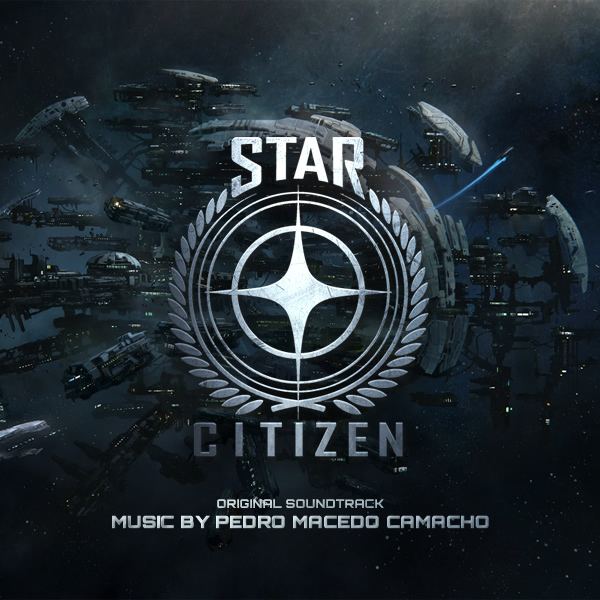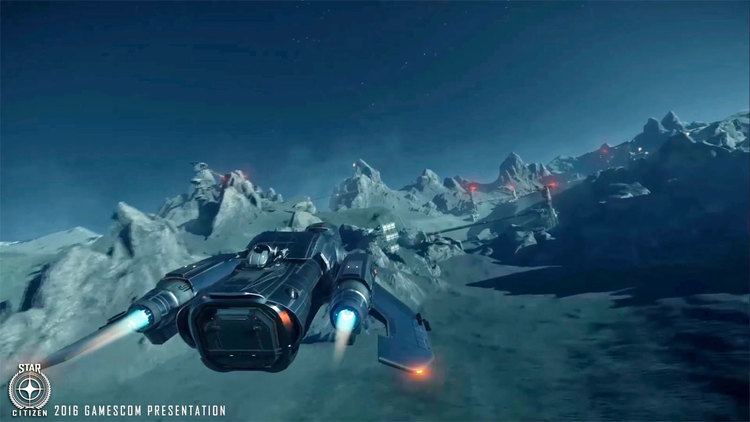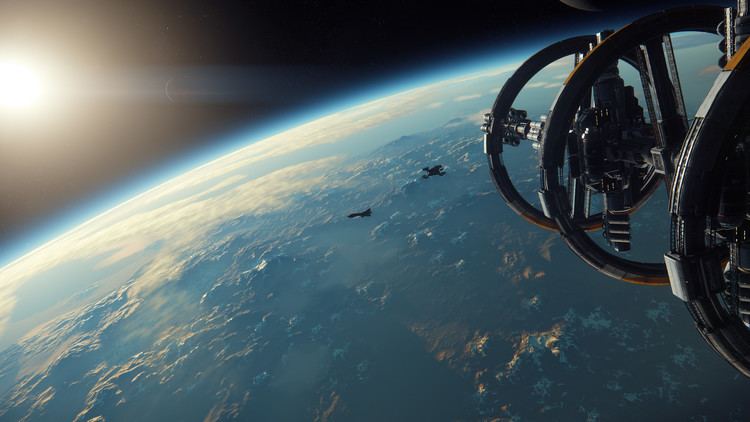Director(s) Chris Roberts Release WW: TBA Designer Chris Roberts Platforms Microsoft Windows, Linux | Writer(s) Dave Haddock Developer Cloud Imperium Games Publisher Cloud Imperium Games | |
 | ||
Engine Amazon Lumberyard
(based on CryEngine) Mode(s) Single-player, multiplayer Composers Pedro Camacho, Geoff Zanelli Genres Space flight simulation game, First-person shooter Similar Chris Roberts games, Space flight simulators, Other games | ||
Star Citizen is an upcoming space trading and combat computer game for Microsoft Windows and Linux. Star Citizen is planned to consist of four main components: first-person space combat, mining, exploration, and trading with first-person shooter elements in a massively multiplayer persistent universe and customizable private servers, and a branching single-player and drop-in co-operative multiplayer campaign titled Squadron 42. The game is built on Amazon Lumberyard.
Contents
- Star citizen pc gaming rig
- Gameplay
- Arena Commander
- Star Marine
- Persistent universe
- Squadron 42
- Development
- Funding
- Rival Games
- References

Both Star Citizen and Squadron 42 are set in a 30th-century Milky Way centered on the fictional United Empire of Earth (UEE). A central theme of the game is citizenship – or lack thereof – in the UEE, which must be earned through player actions such as completing a period of military service. It is anticipated that citizens will enjoy certain in-game benefits, like paying a reduced tax rate, but the exact details are yet to be determined.

A strong focus will be placed on player interaction, with player behavior influencing and being influenced by a dynamic economy system.

Star Citizen and Squadron 42 are produced by Chris Roberts' company Cloud Imperium Games and its European counterpart Foundry 42 and marketed under the Cloud Imperium Games subsidiary Roberts Space Industries.
Star Citizen was announced for commercial launch in 2016 by Chris Roberts at the BAFTA LA Presentation on January 21, 2015. Since then no official release date has been given for Star Citizen and the game is still in active development. The first Episode of Squadron 42 was announced for a Fall 2015 release at the same event but has been delayed multiple times and is now slated for a 2017 release date according to the games homepage.
Star citizen pc gaming rig
Gameplay
Star Citizen aims to combine multiple video game genres, including space trading and combat simulator and first-person shooter elements, in a massively multiplayer online game.
Alluding to Star Citizen's online universe, Chris Roberts highlights the importance of player-driven content: "It's like a sandbox for everybody, and occasionally you'll sprinkle in little bits of scripted content to give a bit of character, but you're letting a lot of the players generate the intrigue and the drama." The economy system is described as being NPC-driven, however, with players slowly taking over to ensure changes in game population do not disrupt the economy.
Roberts emphasizes his focus on immersion: "The changes in the technology in the industry will allow me to do a much more immersive experience. [...] It's all about that suspension of disbelief."
Star Citizen's space combat utilizes a Newtonian physics model to create tactical choices for the player. Players will complete objectives to gain currency used to buy, repair and upgrade their ships or to purchase items used in trade.
The game's first-person shooter mechanics are reported to be inspired by games such as Rainbow Six, ARMA, Counter-Strike and Killzone.
Arena Commander
Arena Commander is the second playable alpha component of Star Citizen. It is an in-fiction space combat simulator allowing players to playtest ship combat against other players or AI opponents. It features a highly detailed ship flight model, simulating space flight using the mass of the ship and location and force of the thrusters. Other features include realistic application of g-force on the pilot and a high level of visual fidelity. Racing and cooperative game modes were added in an update. Of note is the ability to "decouple" ships from the axis of travel to gain a combat advantage.
Star Marine
Star Marine originally announced for release in 2015 is the first-person shooter element of Star Citizen; like Arena Commander, Star Marine is an in-fiction combat simulator. There are two ways to play Star Marine: one game mode is a 'capture-and-hold' game ('Last Stand'), where two opposing teams (the Marines and the Outlaws) each attempt to capture one or more 'control points' to gain points; as a team captures more control points, they gain points at a steadily increasing rate. 'Elimination' is a free-for-all 'last man standing' match; unlike the team-based 'Last Stand', players work individually to gain the highest kill-count before the match ends. Both game variants last for ten minutes or (in the case of 'Last Stand') until one team accrues the higher score. The first person shooter mechanics are designed to be relatively realistic with armor levels, weapon stances and stamina effects manifesting as heavy breathing.
On January 26, 2015, the development of Star Marine was contracted out to a studio called Illfonic; in August 2015, the contract was terminated and development of Star Marine returned to an in-house team at Cloud Imperium Games.
At Gamescom 2016 director, Chris Roberts, confirmed Star Marine will be available to backers in Alpha 2.6. It was released on December 23, 2016 missing many of the promised features like SATABall, a cover system and multiple maps (Gold Horizon, Crusader etc.).
Persistent universe
Star Citizen will continue to develop after commercial release via a combination of emergent gameplay generated by players and new content which will be developed by Cloud Imperium Games on an ongoing basis. Players and organizations will be able to own certain production nodes including factories and mines. Capital ships can be owned and operated by players. Select "lawless planets" will feature ground-based combat using infantry style weapons. Personal armaments can also be used to board disabled ships and stations. Planetary landings and take-offs were demonstrated on the holiday Live-stream on December 16, 2015. The technology is being developed by Foundry 42 in Frankfurt, Germany.
Players will not be separated by different game servers. A matchmaking and instancing mechanic will handle how players connect to each other. The developers plan to include a slider allowing players to determine their level of exposure to other players.
Squadron 42
Squadron 42 originally announced for release in 2014 during the Kickstarter campaign then moved to a 2016 release, and now announced once more for 2017, is a story-based single-player campaign set in the Star Citizen fictional universe described by the developers as a "spiritual successor to Wing Commander". It is being developed by the Foundry 42 UK studio under the supervision of Chris Roberts' brother Erin, who had already worked with him on the "Wing Commander" series and led the production and development of titles like Privateer 2: The Darkening and Starlancer.
The interactive storyline centers on an elite military unit and involves the player character enlisting in the United Empire of Earth Navy, taking part in a campaign that starts with a large space battle. The players' actions will allow them to optionally achieve citizenship in the UEE and affect their status in the Star Citizen persistent universe, but neither of the two games has to be played in order to access the other. In addition to space combat simulation and first-person shooter elements, reported features include a conversation system that affects relationships with non-player pilots and an optional cooperative multiplayer mode. The game is planned to be released in multiple chapters offering an estimated of 20 hours of gameplay for SQ42 Episode 1 with about 70 missions worth of game play, "Squadron 42 Episode Two: Behind Enemy Lines" and "Episode 3," will launch later.
The cast for Squadron 42 includes the following actors and actresses: Gary Oldman playing Admiral Ernst Bishop; Mark Hamill as Lieutenant Commander Steve “Old Man” Colton; Mark Strong; Craig Fairbrass; Liam Cunningham playing Captain Noah White on the UEES Stanton; Ben Mendelsohn; Ian Duncan playing the Protagonist; Jack Huston playing "Sky Captain" Cal Mason; John Rhys-Davies as Graves; Andy Serkis as Thul'Óqquray; Harry Treadaway; Gillian Anderson playing Admiral Bishop's daughter; Sophie Wu playing Petty Officer Webster; Sandi Gardiner; Rhona Mitra playing Executive Officer Kelly on the UEES Stanton, Richard Brake and Gemma Whelan.
Development
Star Citizen and Squadron 42 are produced in a distributed development process by Cloud Imperium Games and Foundry 42 with studios in Austin, Frankfurt, Santa Monica and Wilmslow, in cooperation with Behaviour Interactive and Illfonic. The game's release date has never been officially advertised. The games utilize the artificial intelligence system Kythera, developed by Moon Collider. Additional partners that are or have been working on the project include CGBot, Rmory, The Imaginarium Studios, Turbulent, Virtuos, voidALPHA and Wyrmbyte. The developers also exchange knowledge and technology with Warhorse Studios, the creators of Kingdom Come: Deliverance.
The development of the game started in 2011 with building a demo on a modified version of the CryEngine 3 game engine, later updated to the 4th generation and after four years moving to Amazon Lumberyard that is also a modified version of CryEngine 3.Star Citizen will support AMD's Mantle graphics API. Star Citizen is being developed using a modular approach, with the first module (dubbed the "Hangar Module") released August 29, 2013 in order to coincide with the game's appearance at the 2013 Gamescom trade fair. In March 2017, CIG announced Star Citizen would eventually use Vulkan (API) and drop support for the DirectX API.
The initial alpha release of the Hangar Module allows backers of the project to explore their virtual ships from a 1st person perspective. Subsequent updates to the Hangar Module will include the ability to add upgrades and modifications to players' ships and allow players to invite friends to their hangar. The module system is intended to be iterative in nature, with updated version of modules being released as and when additional functionality and content are finalized.
The second module was released on June 4, 2014. It was officially named Arena Commander and allows backers to playtest the ship combat and racing portion of the game against other players or AI opponents. Future updates to Arena Commander will add multi-crew ships and additional maps.
The first-person shooter component of the game was unveiled at PAX Australia 2014. illFonic was officially revealed as the developer of the module. The presented gameplay demo showcased 4-player cooperative combat on board a space station in both artificial gravity and weightlessness. Notable features include the synchronization of first-person and third-person animations and the separation of head and arm movement. In August 2015 Cloud Imperium Games confirmed in a statement to GamesIndustry.biz that development of the Star Marine module is nearing completion and a 'transitioning' has been in progress as IllFonic's part in the Star Marine FPS module is coming to a close. After the backers kept asking what happened to Star Marine and multiple online publications reported it being cancelled, Chris Roberts addressed the issue in 10 for the Chairman: Episode 75 on January 25, 2016 saying that it is not cancelled and now part of the in house development. Star Marine was finally released at the end of 2016.
In December 2015, a small scale version of the "Persistent Universe" module was released in the form of Alpha 2.0.
Other confirmed modules include a "Planetside" module and a singleplayer/co-op campaign dubbed Squadron 42.
Star Citizen will feature distinctive fictional languages for the three most prominent alien races, the Banu, the Vanduul and the Xi'An. In accordance with the 50 million dollar stretch goal of the game's crowdfunding campaign, the languages are individually created by the developers in partnership with linguistic specialists. Other alien races in Star Citizen are the Tevarin and Kr'Thak.
Star Citizen was a recipient of Wired.com's 2016 Vaporware Awards, citing its long development time and unspecified release date.
Funding
In October 2012, the developers of the game started a crowdfunding campaign on their own website using IgnitionDeck, a crowdfunding plugin for WordPress. Just over a week into the campaign, they also started raising funds via a supplemental Kickstarter campaign. Funding quickly surpassed initial target goals and subsequently additional stretch goals have been added to the funding campaign, most promising more or expanded content at release. The initial end date of the funding campaign on the RSI website was later extended by 10 days to match the Kickstarter end date and enable additional funding. On November 17, 2012, two days before campaign closure, the game achieved the record for highest crowdfunded game project with over US$4.2 million. At initial pledge campaign end, the total pledge amount was above all goals initially set by Cloud Imperium Games and reached US$6.2 million.
After the initial campaign, funding has continued through the game's website. In mid-2013, with US$15 million raised in less than a year, Star Citizen became the "most-funded crowdfunding project anywhere". In 2014, Guinness World Records listed the sum of US$39,680,576 pledged on Star Citizen's website as the "largest single amount ever raised via crowdsourcing". During the 2014 Gamescom event on August 15, Chris Roberts announced the crowdfunding campaign had surpassed US$50 million. As of March 2017, the game has brought in US$145 million from backers. The project continues to collect contributions and the developers are considering offering their proprietary crowdfunding platform as a service to other projects.
For contributing to the project's funding, backers receive virtual rewards in the form of tiered pledge packages, which include a spaceship and credits to buy additional equipment and to cover initial costs in the virtual economy, like fuel and rental fees, but according to the developers, players will be able to earn all backer rewards in the game itself, with the exception of certain cosmetic items and Lifetime Insurance (LTI), without having to spend additional money.
Star Citizen fundraising goal was US$2 million with the supplemental Kickstarter campaign goal set at US$500,000. The developers however set a number of stretch goals for the crowdfunding campaign. Those stretch goals continued long after the initial fundraising campaign ended. Each stretch goal promised the addition of extra game features, the release of decorative in-game items, or the addition of new ships to the final game.
The referral program was introduced in conjunction with their Citizencon 2015 event, to reward existing star citizens with recruitment points that work towards digital items in game and new citizens using referral codes receive 5.000 United Earth Credits (UEC) in-game currency, which are used in Voyager Direct online store. The main aim of this program is to increase the Star Citizen community and backing of the title before launch.
Rival Games
Along with Star Citizen, other games contributed to the resurgence of space games. In a Polygon opinion article, Charlie Hall compared Star Citizen to No Man's Sky and Elite: Dangerous, stating that each game has something different to offer within the space sim genre. PC Gamer writer Luke Winkie also compared Star Citizen to No Man's Sky, describing Star Citizen as "the other super ambitious, controversial space sim on the horizon".
